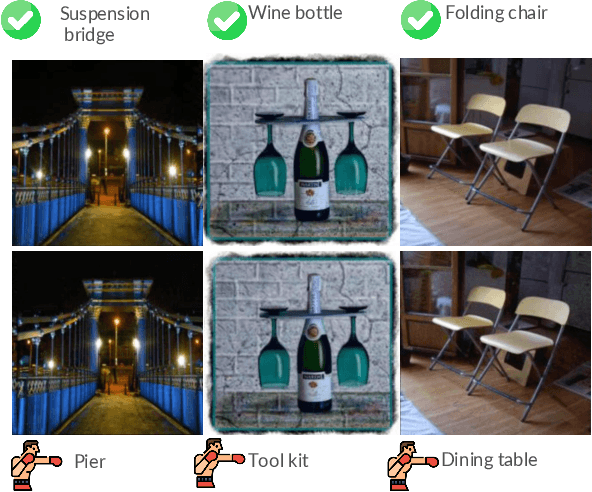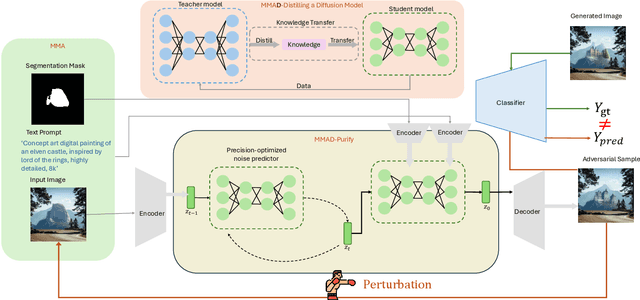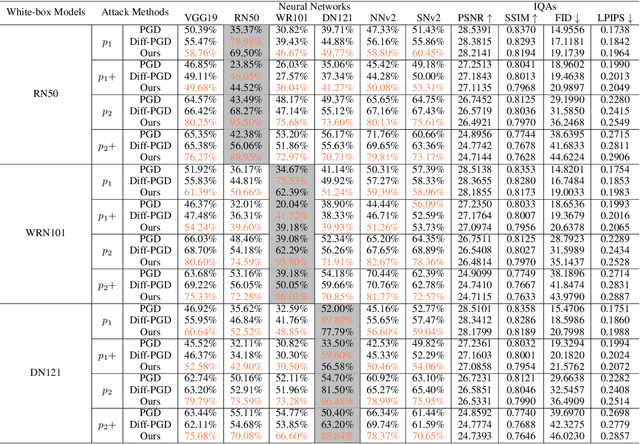Chun Pong Lau
T2ICount: Enhancing Cross-modal Understanding for Zero-Shot Counting
Feb 28, 2025Abstract:Zero-shot object counting aims to count instances of arbitrary object categories specified by text descriptions. Existing methods typically rely on vision-language models like CLIP, but often exhibit limited sensitivity to text prompts. We present T2ICount, a diffusion-based framework that leverages rich prior knowledge and fine-grained visual understanding from pretrained diffusion models. While one-step denoising ensures efficiency, it leads to weakened text sensitivity. To address this challenge, we propose a Hierarchical Semantic Correction Module that progressively refines text-image feature alignment, and a Representational Regional Coherence Loss that provides reliable supervision signals by leveraging the cross-attention maps extracted from the denosing U-Net. Furthermore, we observe that current benchmarks mainly focus on majority objects in images, potentially masking models' text sensitivity. To address this, we contribute a challenging re-annotated subset of FSC147 for better evaluation of text-guided counting ability. Extensive experiments demonstrate that our method achieves superior performance across different benchmarks. Code is available at https://github.com/cha15yq/T2ICount.
MMAD-Purify: A Precision-Optimized Framework for Efficient and Scalable Multi-Modal Attacks
Oct 17, 2024



Abstract:Neural networks have achieved remarkable performance across a wide range of tasks, yet they remain susceptible to adversarial perturbations, which pose significant risks in safety-critical applications. With the rise of multimodality, diffusion models have emerged as powerful tools not only for generative tasks but also for various applications such as image editing, inpainting, and super-resolution. However, these models still lack robustness due to limited research on attacking them to enhance their resilience. Traditional attack techniques, such as gradient-based adversarial attacks and diffusion model-based methods, are hindered by computational inefficiencies and scalability issues due to their iterative nature. To address these challenges, we introduce an innovative framework that leverages the distilled backbone of diffusion models and incorporates a precision-optimized noise predictor to enhance the effectiveness of our attack framework. This approach not only enhances the attack's potency but also significantly reduces computational costs. Our framework provides a cutting-edge solution for multi-modal adversarial attacks, ensuring reduced latency and the generation of high-fidelity adversarial examples with superior success rates. Furthermore, we demonstrate that our framework achieves outstanding transferability and robustness against purification defenses, outperforming existing gradient-based attack models in both effectiveness and efficiency.
Instant Adversarial Purification with Adversarial Consistency Distillation
Sep 02, 2024



Abstract:Neural networks, despite their remarkable performance in widespread applications, including image classification, are also known to be vulnerable to subtle adversarial noise. Although some diffusion-based purification methods have been proposed, for example, DiffPure, those methods are time-consuming. In this paper, we propose One Step Control Purification (OSCP), a diffusion-based purification model that can purify the adversarial image in one Neural Function Evaluation (NFE) in diffusion models. We use Latent Consistency Model (LCM) and ControlNet for our one-step purification. OSCP is computationally friendly and time efficient compared to other diffusion-based purification methods; we achieve defense success rate of 74.19\% on ImageNet, only requiring 0.1s for each purification. Moreover, there is a fundamental incongruence between consistency distillation and adversarial perturbation. To address this ontological dissonance, we propose Gaussian Adversarial Noise Distillation (GAND), a novel consistency distillation framework that facilitates a more nuanced reconciliation of the latent space dynamics, effectively bridging the natural and adversarial manifolds. Our experiments show that the GAND does not need a Full Fine Tune (FFT); PEFT, e.g., LoRA is sufficient.
A Grey-box Attack against Latent Diffusion Model-based Image Editing by Posterior Collapse
Aug 20, 2024Abstract:Recent advancements in generative AI, particularly Latent Diffusion Models (LDMs), have revolutionized image synthesis and manipulation. However, these generative techniques raises concerns about data misappropriation and intellectual property infringement. Adversarial attacks on machine learning models have been extensively studied, and a well-established body of research has extended these techniques as a benign metric to prevent the underlying misuse of generative AI. Current approaches to safeguarding images from manipulation by LDMs are limited by their reliance on model-specific knowledge and their inability to significantly degrade semantic quality of generated images. In response to these shortcomings, we propose the Posterior Collapse Attack (PCA) based on the observation that VAEs suffer from posterior collapse during training. Our method minimizes dependence on the white-box information of target models to get rid of the implicit reliance on model-specific knowledge. By accessing merely a small amount of LDM parameters, in specific merely the VAE encoder of LDMs, our method causes a substantial semantic collapse in generation quality, particularly in perceptual consistency, and demonstrates strong transferability across various model architectures. Experimental results show that PCA achieves superior perturbation effects on image generation of LDMs with lower runtime and VRAM. Our method outperforms existing techniques, offering a more robust and generalizable solution that is helpful in alleviating the socio-technical challenges posed by the rapidly evolving landscape of generative AI.
Self-Supervised Learning of Whole and Component-Based Semantic Representations for Person Re-Identification
Dec 01, 2023Abstract:Interactive Segmentation Models (ISMs) like the Segment Anything Model have significantly improved various computer vision tasks, yet their application to Person Re-identification (ReID) remains limited. On the other hand, existing semantic pre-training models for ReID often have limitations like predefined parsing ranges or coarse semantics. Additionally, ReID and Clothes-Changing ReID (CC-ReID) are usually treated separately due to their different domains. This paper investigates whether utilizing precise human-centric semantic representation can boost the ReID performance and improve the generalization among various ReID tasks. We propose SemReID, a self-supervised ReID model that leverages ISMs for adaptive part-based semantic extraction, contributing to the improvement of ReID performance. SemReID additionally refines its semantic representation through techniques such as image masking and KoLeo regularization. Evaluation across three types of ReID datasets -- standard ReID, CC-ReID, and unconstrained ReID -- demonstrates superior performance compared to state-of-the-art methods. In addition, recognizing the scarcity of large person datasets with fine-grained semantics, we introduce the novel LUPerson-Part dataset to assist ReID methods in acquiring the fine-grained part semantics for robust performance.
Instruct2Attack: Language-Guided Semantic Adversarial Attacks
Nov 27, 2023Abstract:We propose Instruct2Attack (I2A), a language-guided semantic attack that generates semantically meaningful perturbations according to free-form language instructions. We make use of state-of-the-art latent diffusion models, where we adversarially guide the reverse diffusion process to search for an adversarial latent code conditioned on the input image and text instruction. Compared to existing noise-based and semantic attacks, I2A generates more natural and diverse adversarial examples while providing better controllability and interpretability. We further automate the attack process with GPT-4 to generate diverse image-specific text instructions. We show that I2A can successfully break state-of-the-art deep neural networks even under strong adversarial defenses, and demonstrate great transferability among a variety of network architectures.
Whole-body Detection, Recognition and Identification at Altitude and Range
Nov 09, 2023Abstract:In this paper, we address the challenging task of whole-body biometric detection, recognition, and identification at distances of up to 500m and large pitch angles of up to 50 degree. We propose an end-to-end system evaluated on diverse datasets, including the challenging Biometric Recognition and Identification at Range (BRIAR) dataset. Our approach involves pre-training the detector on common image datasets and fine-tuning it on BRIAR's complex videos and images. After detection, we extract body images and employ a feature extractor for recognition. We conduct thorough evaluations under various conditions, such as different ranges and angles in indoor, outdoor, and aerial scenarios. Our method achieves an average F1 score of 98.29% at IoU = 0.7 and demonstrates strong performance in recognition accuracy and true acceptance rate at low false acceptance rates compared to existing models. On a test set of 100 subjects with 444 distractors, our model achieves a rank-20 recognition accuracy of 75.13% and a TAR@1%FAR of 54.09%.
GADER: GAit DEtection and Recognition in the Wild
Jul 27, 2023



Abstract:Gait recognition holds the promise of robustly identifying subjects based on their walking patterns instead of color information. While previous approaches have performed well for curated indoor scenes, they have significantly impeded applicability in unconstrained situations, e.g. outdoor, long distance scenes. We propose an end-to-end GAit DEtection and Recognition (GADER) algorithm for human authentication in challenging outdoor scenarios. Specifically, GADER leverages a Double Helical Signature to detect the fragment of human movement and incorporates a novel gait recognition method, which learns representations by distilling from an auxiliary RGB recognition model. At inference time, GADER only uses the silhouette modality but benefits from a more robust representation. Extensive experiments on indoor and outdoor datasets demonstrate that the proposed method outperforms the State-of-The-Arts for gait recognition and verification, with a significant 20.6% improvement on unconstrained, long distance scenes.
DiffProtect: Generate Adversarial Examples with Diffusion Models for Facial Privacy Protection
May 23, 2023



Abstract:The increasingly pervasive facial recognition (FR) systems raise serious concerns about personal privacy, especially for billions of users who have publicly shared their photos on social media. Several attempts have been made to protect individuals from being identified by unauthorized FR systems utilizing adversarial attacks to generate encrypted face images. However, existing methods suffer from poor visual quality or low attack success rates, which limit their utility. Recently, diffusion models have achieved tremendous success in image generation. In this work, we ask: can diffusion models be used to generate adversarial examples to improve both visual quality and attack performance? We propose DiffProtect, which utilizes a diffusion autoencoder to generate semantically meaningful perturbations on FR systems. Extensive experiments demonstrate that DiffProtect produces more natural-looking encrypted images than state-of-the-art methods while achieving significantly higher attack success rates, e.g., 24.5% and 25.1% absolute improvements on the CelebA-HQ and FFHQ datasets.
Attribute-Guided Encryption with Facial Texture Masking
May 22, 2023



Abstract:The increasingly pervasive facial recognition (FR) systems raise serious concerns about personal privacy, especially for billions of users who have publicly shared their photos on social media. Several attempts have been made to protect individuals from unauthorized FR systems utilizing adversarial attacks to generate encrypted face images to protect users from being identified by FR systems. However, existing methods suffer from poor visual quality or low attack success rates, which limit their usability in practice. In this paper, we propose Attribute Guided Encryption with Facial Texture Masking (AGE-FTM) that performs a dual manifold adversarial attack on FR systems to achieve both good visual quality and high black box attack success rates. In particular, AGE-FTM utilizes a high fidelity generative adversarial network (GAN) to generate natural on-manifold adversarial samples by modifying facial attributes, and performs the facial texture masking attack to generate imperceptible off-manifold adversarial samples. Extensive experiments on the CelebA-HQ dataset demonstrate that our proposed method produces more natural-looking encrypted images than state-of-the-art methods while achieving competitive attack performance. We further evaluate the effectiveness of AGE-FTM in the real world using a commercial FR API and validate its usefulness in practice through an user study.
 Add to Chrome
Add to Chrome Add to Firefox
Add to Firefox Add to Edge
Add to Edge